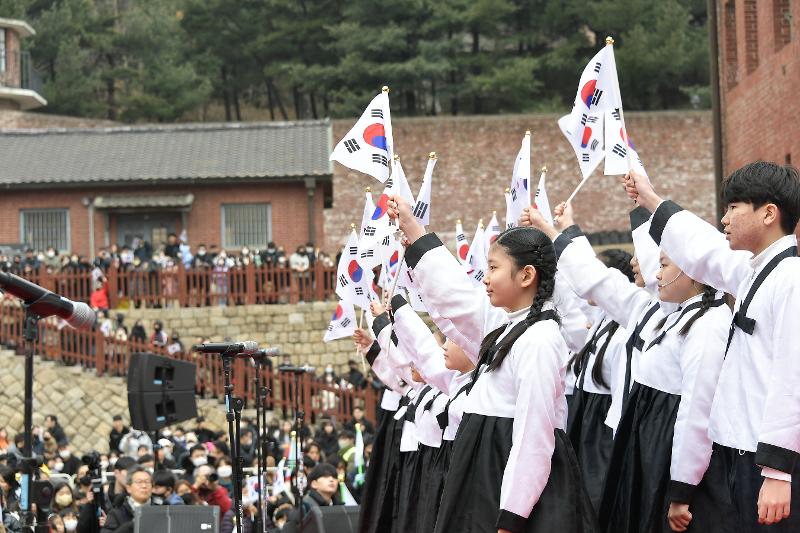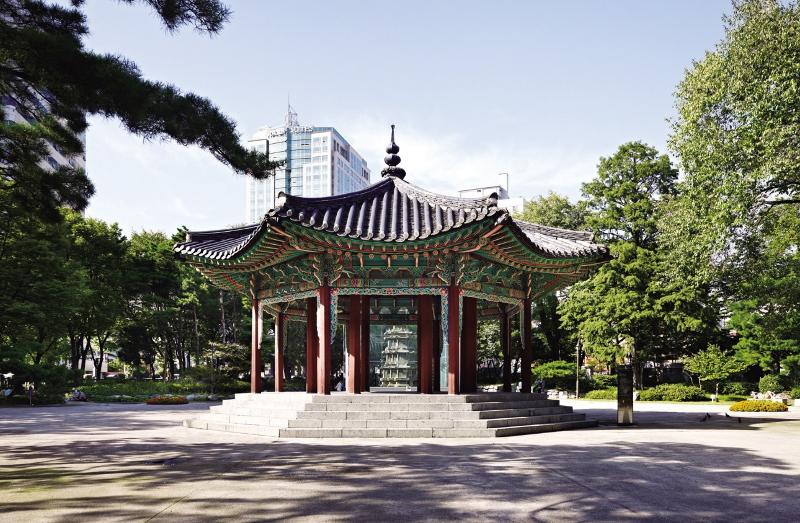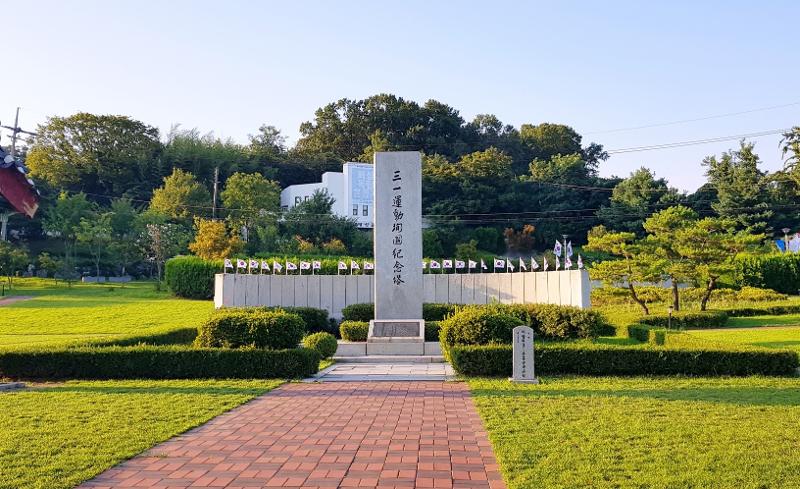
March 1, 1919, is when the March First Independence Movement began as Koreans flooded the streets to announce the nation's Declaration of Independence and protesting Japanese colonial rule. Shown are students on March 1, 2023, waving the national flag Taegeukgi at the "Seodaemun, the Shout of That Day in 1919" on March 1 last year on the movement's 104th anniversary at Seodaemun Prison History Hall in Seoul's Seodaemun-gu District. (Seodaemun-gu Office)
By Yoon Seungjin
March 1, 1919, was a historic day on which Koreans protested Japanese colonial rule, issued a declaration of liberation and launched the March First Independence Movement.
The non-violent and peaceful movement played a crucial role in spreading to the world Korea's desire for independence and raising awareness of resistance to colonial rule elsewhere. The campaign was widely publicized at home and abroad and inspired similar actions in neighboring countries that were ruled as colonies.
For instance, the movement inspired the May Fourth Movement of China, an anti-imperialist revolutionary initiative led by students in the Beijing area on May 4, 1919, and the peaceful Civil Disobedience Movement in India led by Mahatma Gandhi.
To commemorate the movement, the Korean Provisional Government in 1920 designated March 1 the day of the nation's independence day and a national holiday. Every March 1, the country holds a commemorative ceremony and events are held nationwide to mark the occasion like reenactments of the rallies in 1919.
On the movement's 105th anniversary this year, the following three historical sites are recommended for foreign nationals in Korea who wish to learn more about the holiday's significance and gain deeper insight into Korean history and culture. The three were selected based on recommendations from famed history lecturer Choi Tae Seong and Sogang University history professor Jeong Il-young.
1. Tapgol Park in Seoul

Tapgol Park, the country's first urban park and located in Seoul's Jongno-gu District, is a historical site of the March First Independence Movement, the nation's largest resistance movement against Japanese colonial rule. The Declaration of Independence was read at the park's Palgakjeong Pavilion on March 1, 1919. (Cultural Heritage Administration)
Tapgol Park in Seoul's Jongno-gu District, the nation's first urban facility of its kind, is where the movement began.
On March 1, 1919 at 2 p.m., masses of students and citizens gathered there to wait for the 33 signers of the Declaration of Independence, but the latter had gone elsewhere to read it to avoid Japanese surveillance.
Despite their absence, a young man climbed up the steps of Palgakjeong Pavilion at the park and began to read the declaration. His action prompted shouts from the crowd of "Long live Korean independence" and marches on the streets of Jongno in downtown Seoul, and this is considered the beginning of the movement.
"The ceremony for the Declaration of Independence at Tapgol Park led by students and citizens was significant," lecturer Choi said. "It was where the cry of 'Long live Korean independence' began and spread from Seoul to the entire country and abroad."
Other notable landmarks at the park include Movement Memorial Tower, murals on the movement and the statue of patriotic martyr Uiam Son Byong-hi, a leader of the movement and one of the 33 signers of the declaration.
2. Seodaemun Prison History Hall
Built by Japan to begin its annexation of Korea, Seodaemun Prison in Seoul was a tool of oppression. (Cultural Heritage Administration)
The Japanese Government-General of Korea in 1908 opened Seodaemun Prison in Seoul to advance Japan's annexation of the Korean Peninsula.
Many independence activists who fought Japanese colonial rule were imprisoned and tortured at the prison until national liberation in 1945. Patriotic martyrs like Kim Koo, Kang Woo-kyu and Yu Gwan-sun were detained here.
On March 1, 1920, Yu marked the movement's first anniversary by leading the cry "Long live Korean independence" with fellow activists held at Cell No. 8 of the women's section of the prison, displaying her undying fervor for independence. She died there on Sept. 28 that year, just two days before her scheduled release.
Seodaemun Prison History Hall is a museum honoring the movement by restoring the prison's original condition during the Japanese occupation. Artifacts and prison sentence cards of activists and freedom fighters are displayed, and cells allow visitors to see firsthand life for the imprisoned activists.
The museum and the area around Dongnimmun (Independence) Gate from March 1-2 host the commemorative event "Seodaemun, the Shout That Day in 1919" to mark the 105th anniversary of the movement.
3. Historic Site of March First Independence Movement in Jeam-ri, Hwaseong

The village of Jeam-ri in Hwaseong, Gyeonggi-do Province, is where the worst massacre during Japanese colonial rule of Korea occurred during the movement. A memorial tower for the movement's patriotic martyrs stands near Jeam-ri Protestant Church where the incident occurred. (Federation of Korea Culture Center's Local & Culture)
At the height of the movement, the village of Jeam-ri in Hwaseong, Gyeonggi-do Province, saw the most brutal act of repression during the movement by the Japanese colonial government.
The movement extended far beyond a single day, spreading across the peninsula to reach Japan and Russia's Primorsky Krai and continuing for about a year. The Japanese government responded with brute force by mobilizing police and military personnel, resulting in massacres in the villages of Jeam-ri and Goju-ri.
On April 15, 1919, Japanese soldiers forced around 20 male Christians and Cheondoists into Jeam-ri Protestant Church and locked the doors and windows there. The troops then slaughtered them with bayonets and guns and burned the church afterwards, preventing any of the victims from escaping either the fire or the building by shooting or bayoneting them.
A memorial tower for the patriotic martyrs is at the site of the church and the area was designated Historic Site of the March First Independence Movement in Jeam-ri, Hwaseong.
A nearby memorial hall used for public education until April last year displays domestic and foreign materials related to the movement. It will be reopened in April this year under the name Hwaseong Independence Movement Memorial Hall following renovation of the site and construction of new facilities.
scf2979@korea.kr
Most popular
- Military discharge sets stage for reunion of all 7 BTS members
- 'We are back!' BTS Festa heralds hyped return of K-pop phenom
- Presidents Lee, Trump discuss tariff deal in first phone talks
- 'Maybe Happy Ending' wins 6 Tonys including Best Musical
- President Lee leaves for G7 Summit in Canada on first int'l trip
